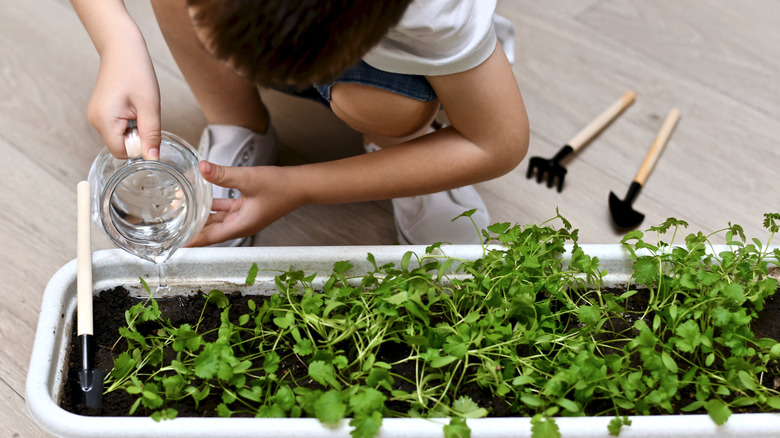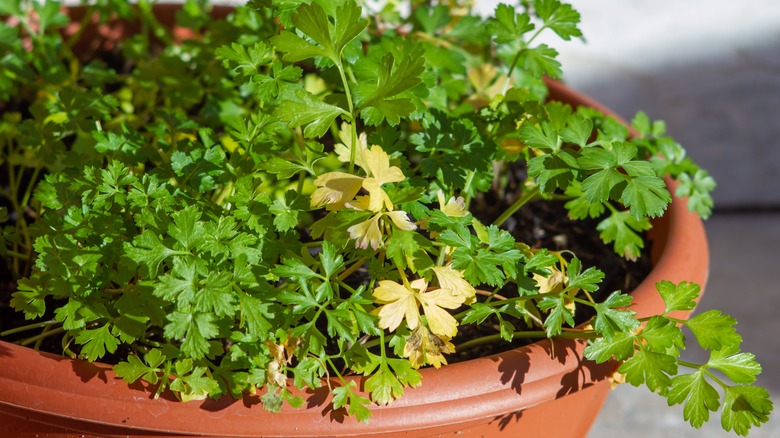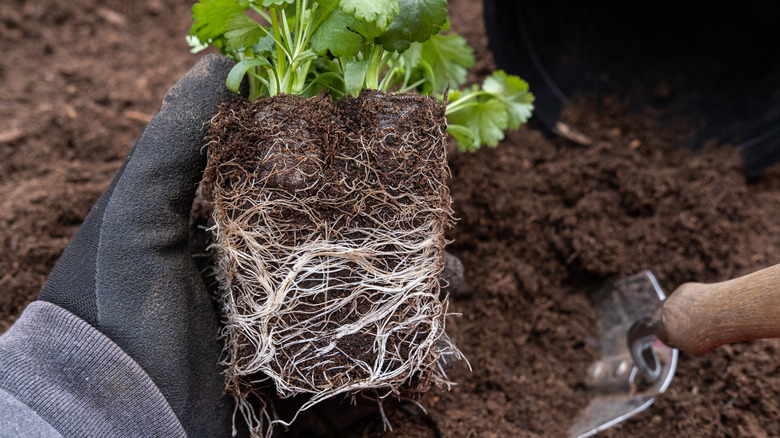Here's How You Can Bring A Dying Cilantro Plant Back To Life
Cilantro (Coriandrum sativum), better known as the leaves and stem of the coriander plant, is a versatile and aromatic herb that's often counted among the top herbs worth growing in your garden. However, caring for cilantro plants can be trickier than imagined. This is because a slight change in their growing conditions can vastly impair their growth, causing the cilantro leaves to wilt, turn yellow or brown, droop, or die completely. The most common reason is inadequate watering and exposure to direct sunlight.
But this doesn't mean that a dying cilantro plant cannot be nursed back to life. Ensuring that your herb receives adequate sunlight, not exceeding six hours on any given day, will take care of any temporary wilting. Further, providing it with adequate water, straw mulches, and well-drained, slightly acidic (6.5 pH) soil should take care of most other problems. Pruning your cilantro plant right before it starts bolting can further enhance its life span.
Dealing with an adverse growth environment
To rescue your dying cilantro plant, you must first assess its growing conditions. Being a cool-season herb, cilantro leaves can wilt prematurely when exposed to harsh sunlight. Moving the plant to a partially shaded area and limiting its sun exposure to about six hours per day will help restore the plant to its former lush glory. Similarly, cilantro's lifespan decreases when it experiences high temperatures exceeding 80 degrees Fahrenheit, as the heat dehydrates the herb, reducing moisture content. To counter this, add mulch to the soil.
As this annual plant's water requirements change according to its lifecycle, you must take care not to over or underwater your cilantro plant. The easy way is to check the top 2 inches of your topsoil for dryness and then only water it when that top layer is dry. Avoid overwatering your plant, which could lead to root rot. In comparison, underwatering can lead to the browning of cilantro leaves, necessitating an increase in watering frequency of at least once a week and up to three times a week during hotter days.
Other ways to revive your cilantro plant
If the above methods don't revive your dying cilantro plant, check its leaves for signs of discoloration, which might indicate a nutrient deficiency. To remedy this, feed your cilantro with a balanced fertilizer containing nitrogen, phosphorus, and potassium in a 1:1:1 ratio every two weeks to encourage growth. Overcrowding can also cause your plant to wilt. If so, space your herbaceous plant at least 6 to 8 inches apart. For cilantro planted indoors, move them into bigger pots with adequate drainage holes.
Your cilantro plant can also go into a shock when transplanted, as its taproots are temperature-sensitive, especially when replanted from the indoors or greenhouses into your garden. To prevent its stems from wilting and its growth from stunting, ensure the plant's sunlight, water, and soil requirements are met. Moreover, pruning its stems to a height of 8 inches can also help if it is bolting, as the nutrients are redirected to growing more leaves rather than seeds. Finally, pest infestations like leafhoppers and bacterial diseases like coriander bacterial blight and soft rot can also affect your plant's health, necessitating professional help.


